This project report, prepared by a group of civil engineering students at Sardar Patel College of Engineering, focuses on pervious concrete, highlighting its design, applications, and environmental benefits. The study investigates the use of recycled concrete aggregates (RCA) in pervious concrete, examining its effects on density, strength, and permeability, ultimately finding that up to 50% RCA can be used without significant compromise. The report encompasses various methodologies, literature reviews, and assessments to explore the potential of pervious concrete in addressing stormwater management issues in urban areas.
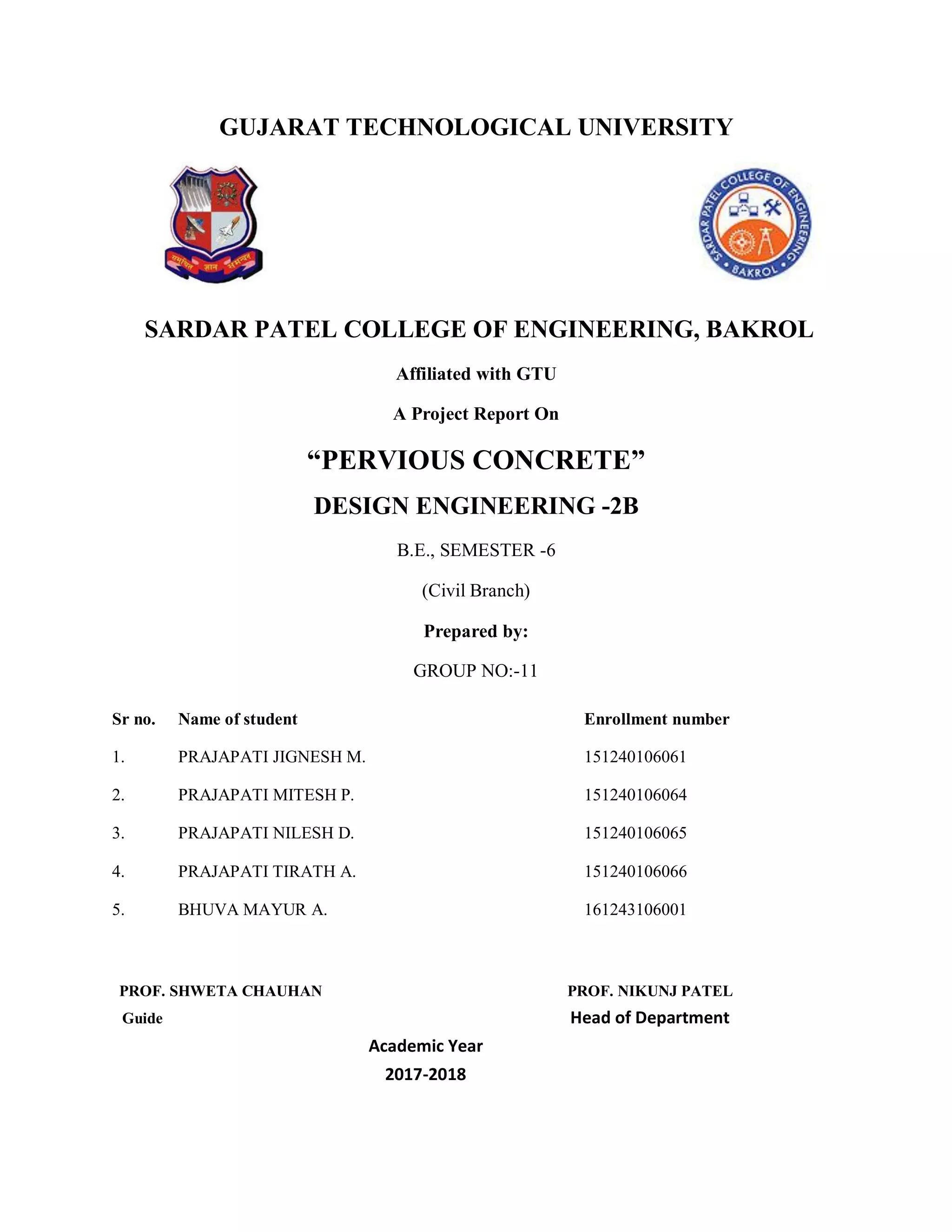
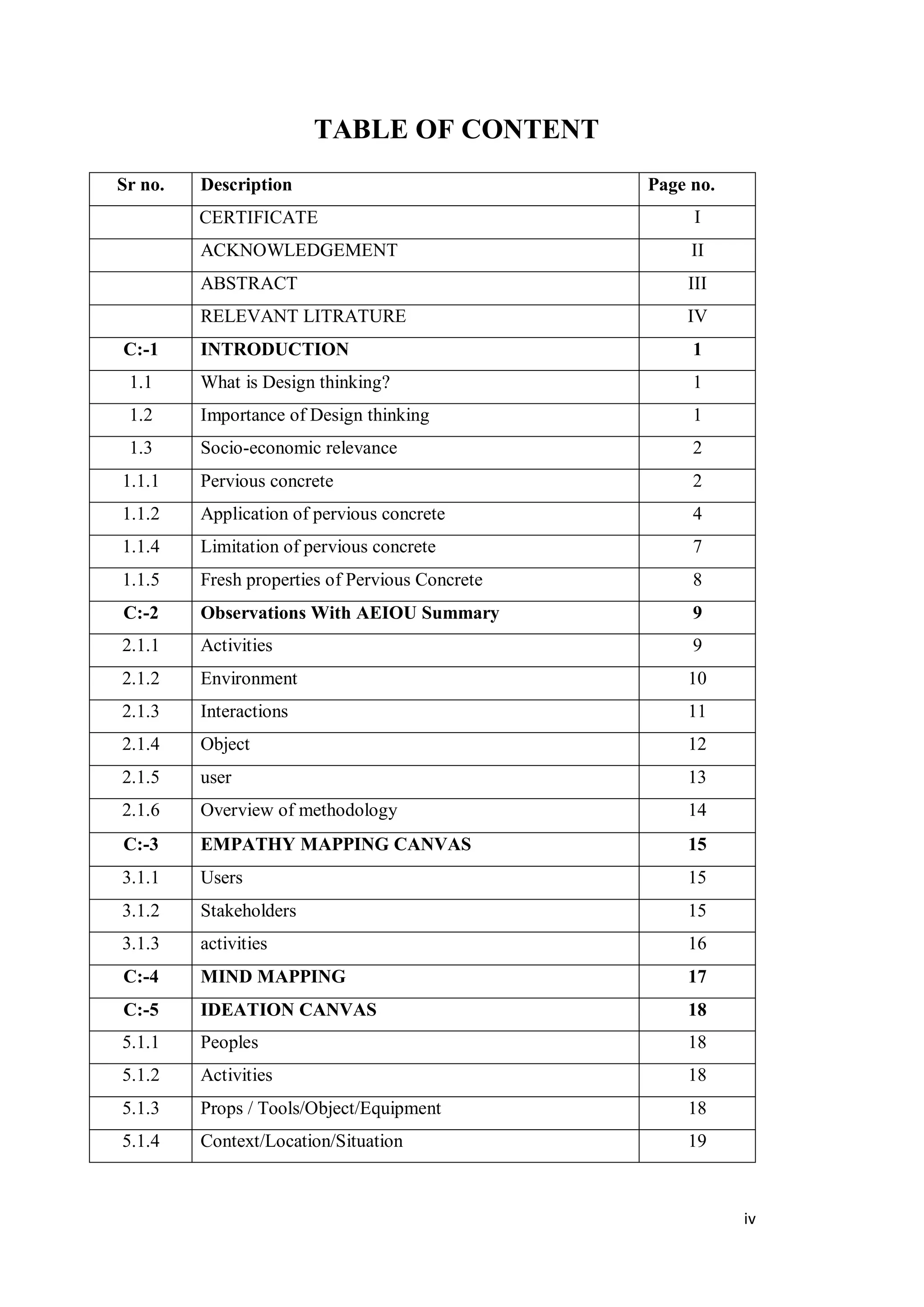







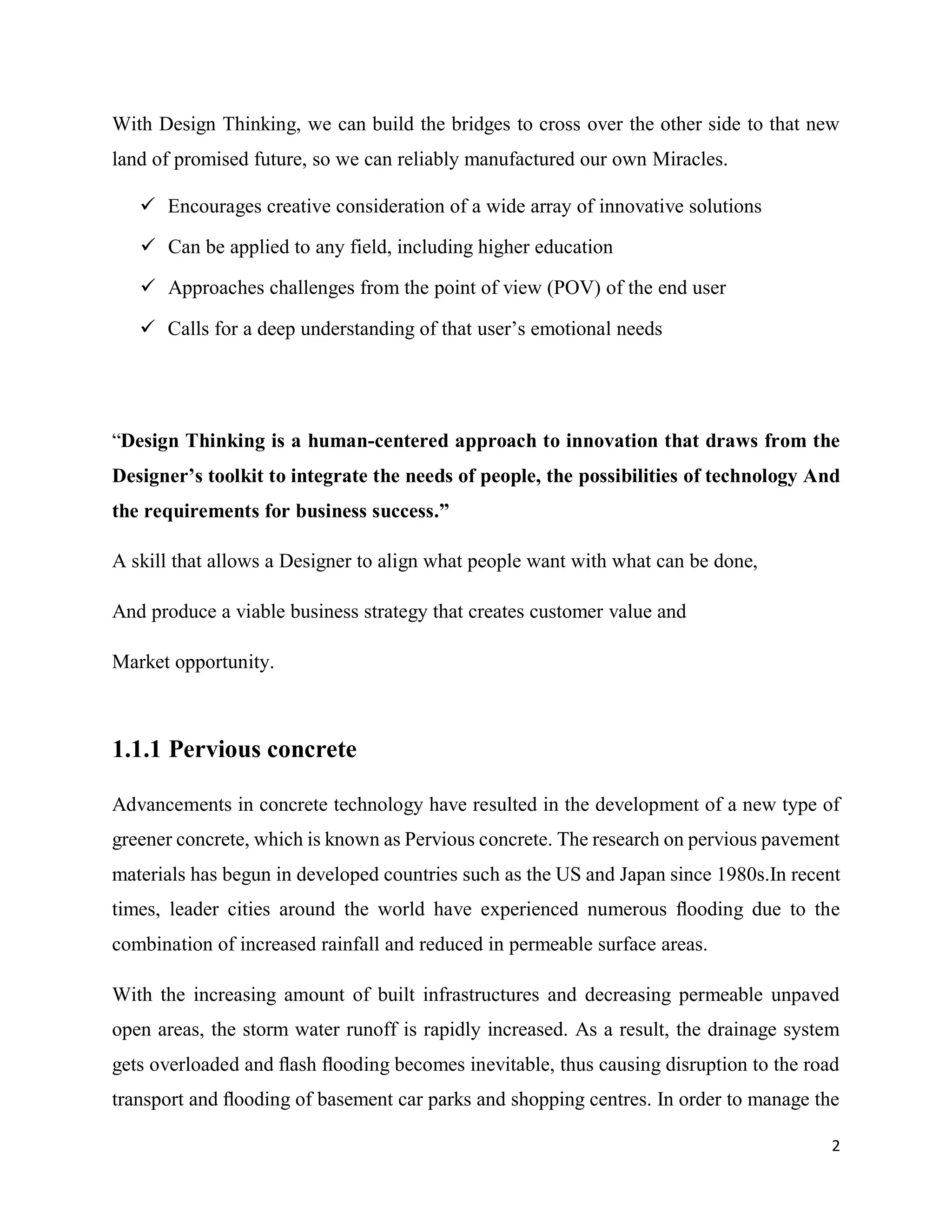




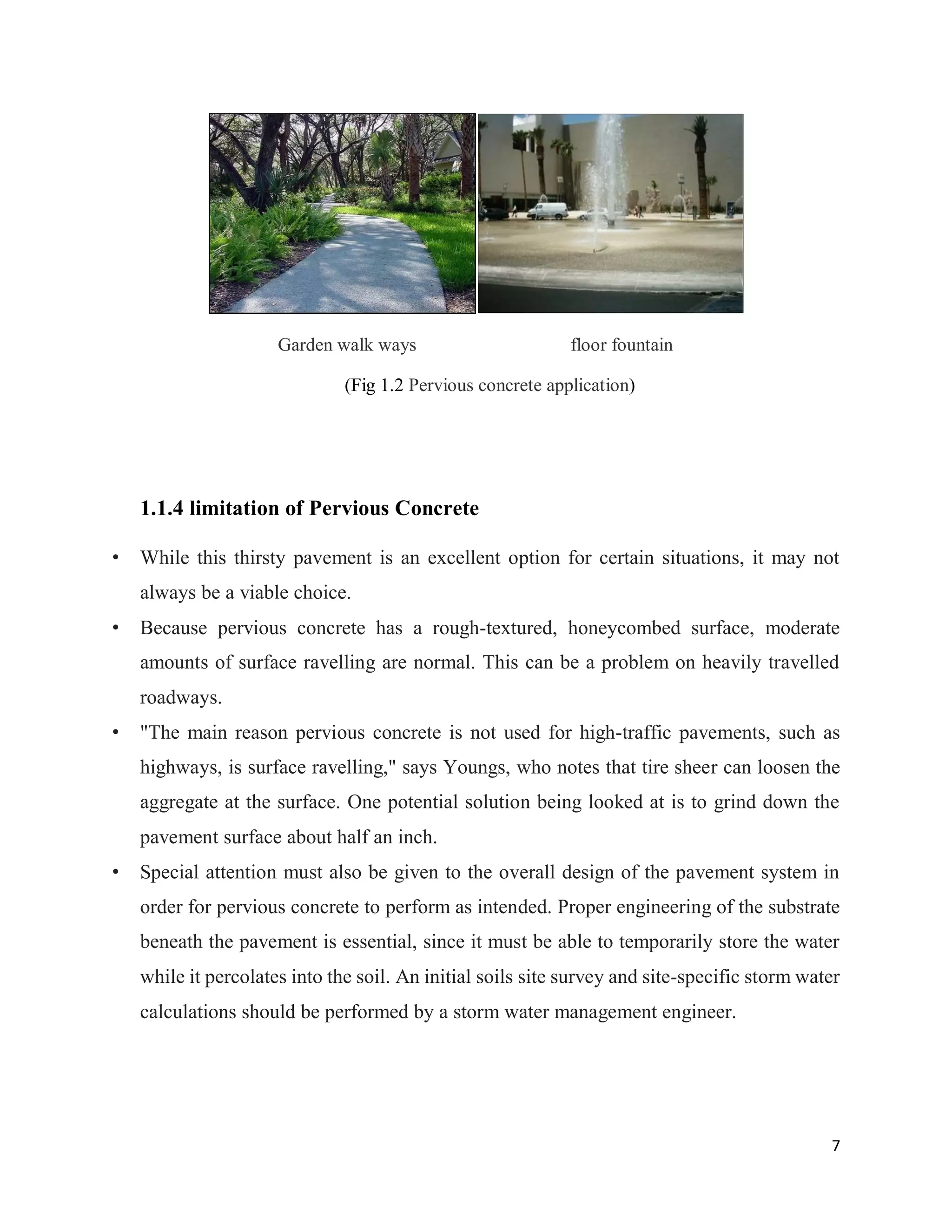





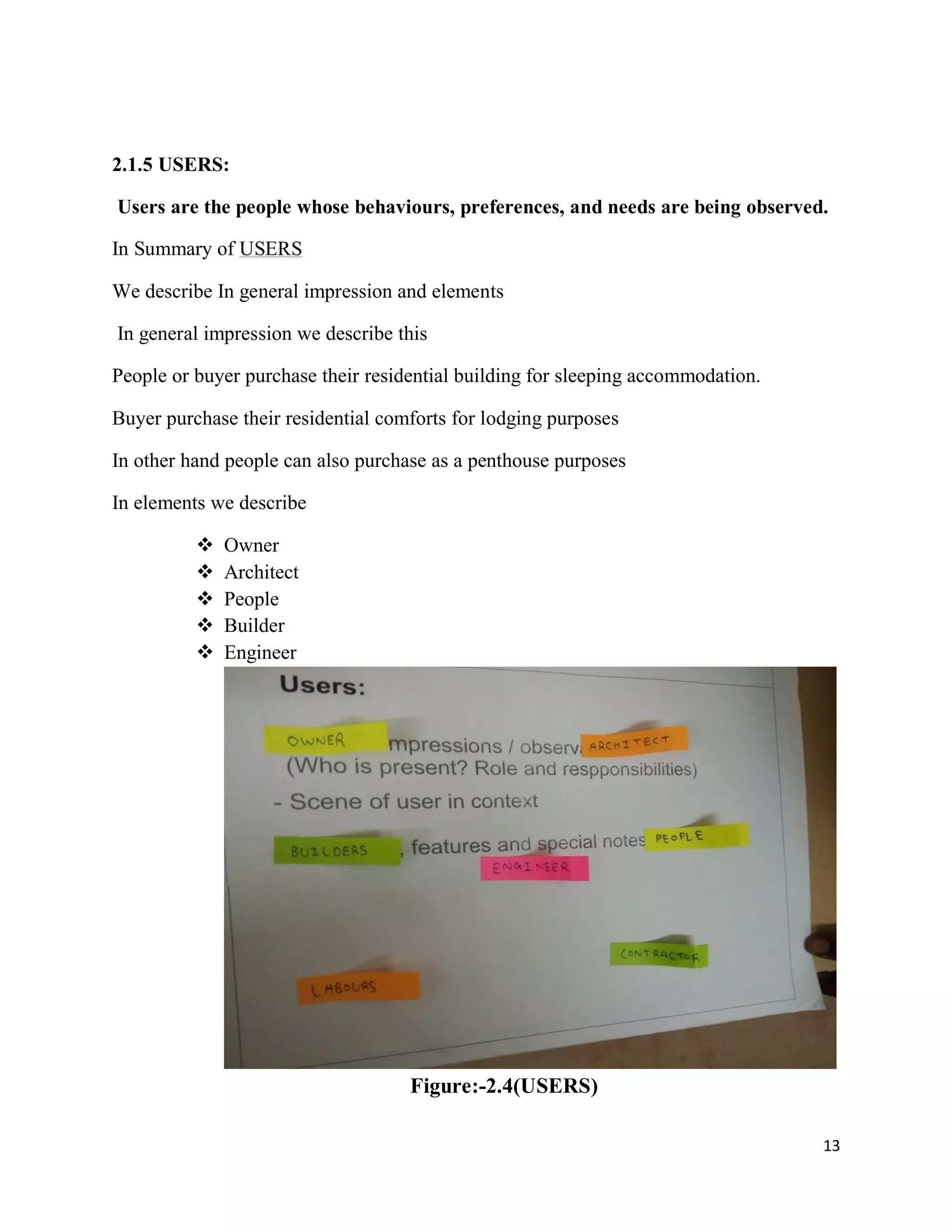

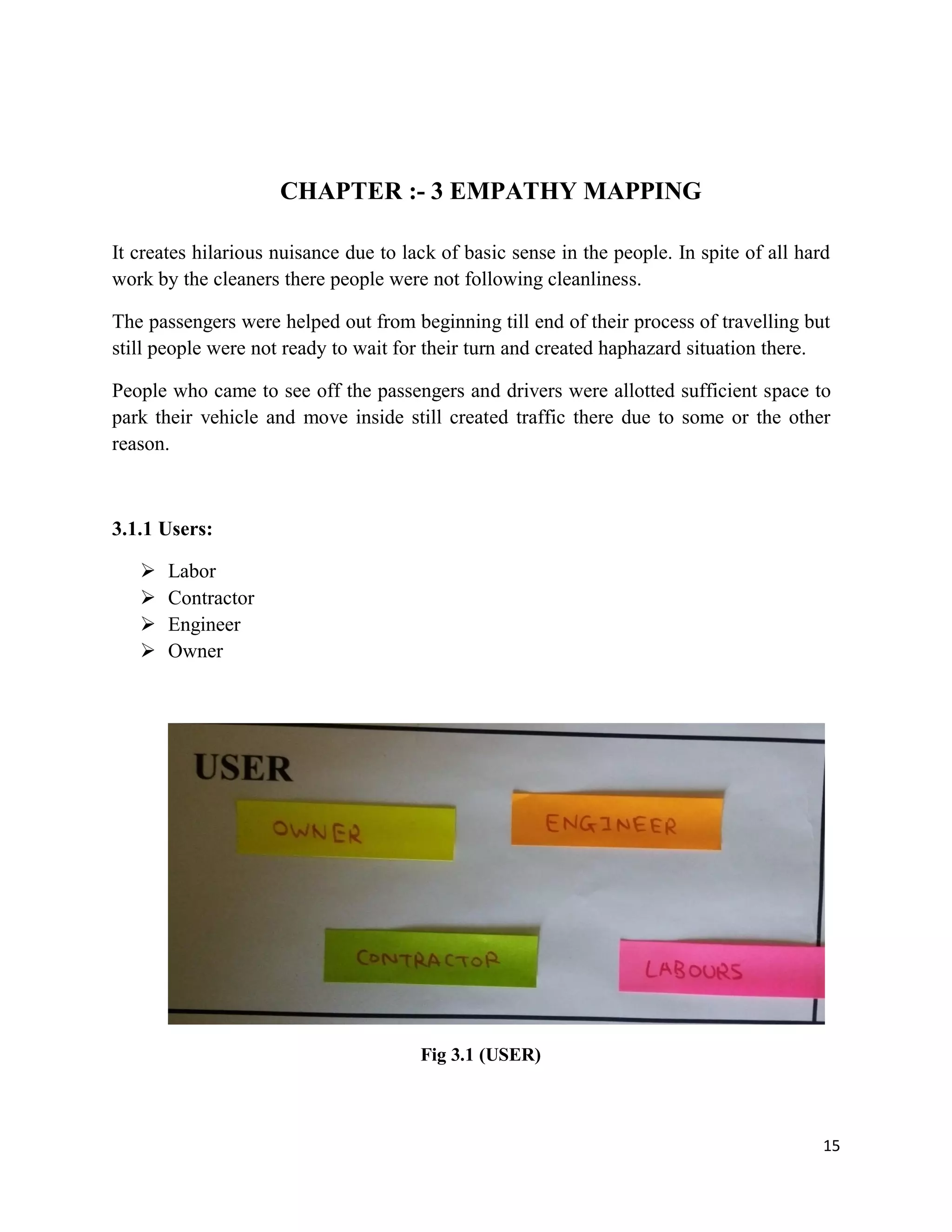
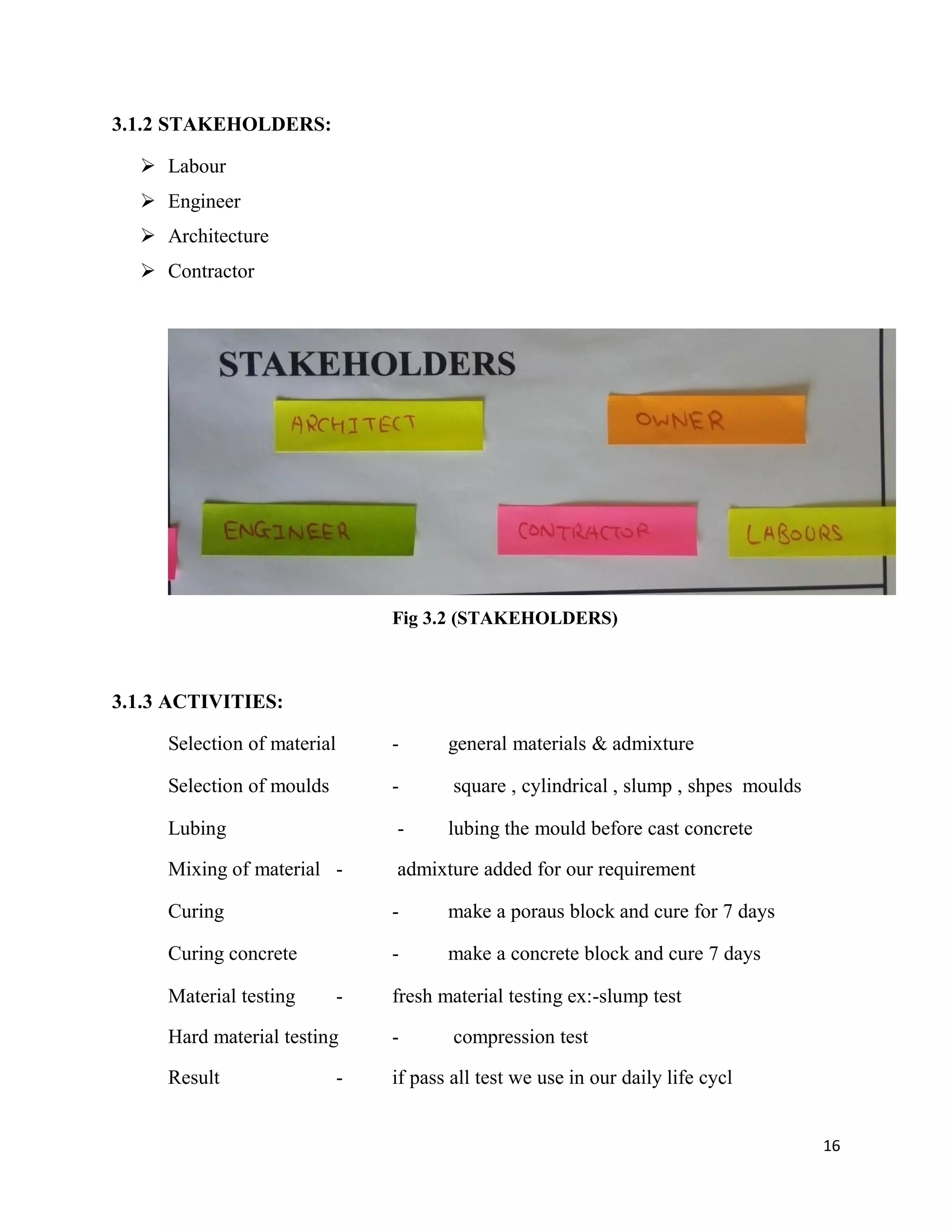






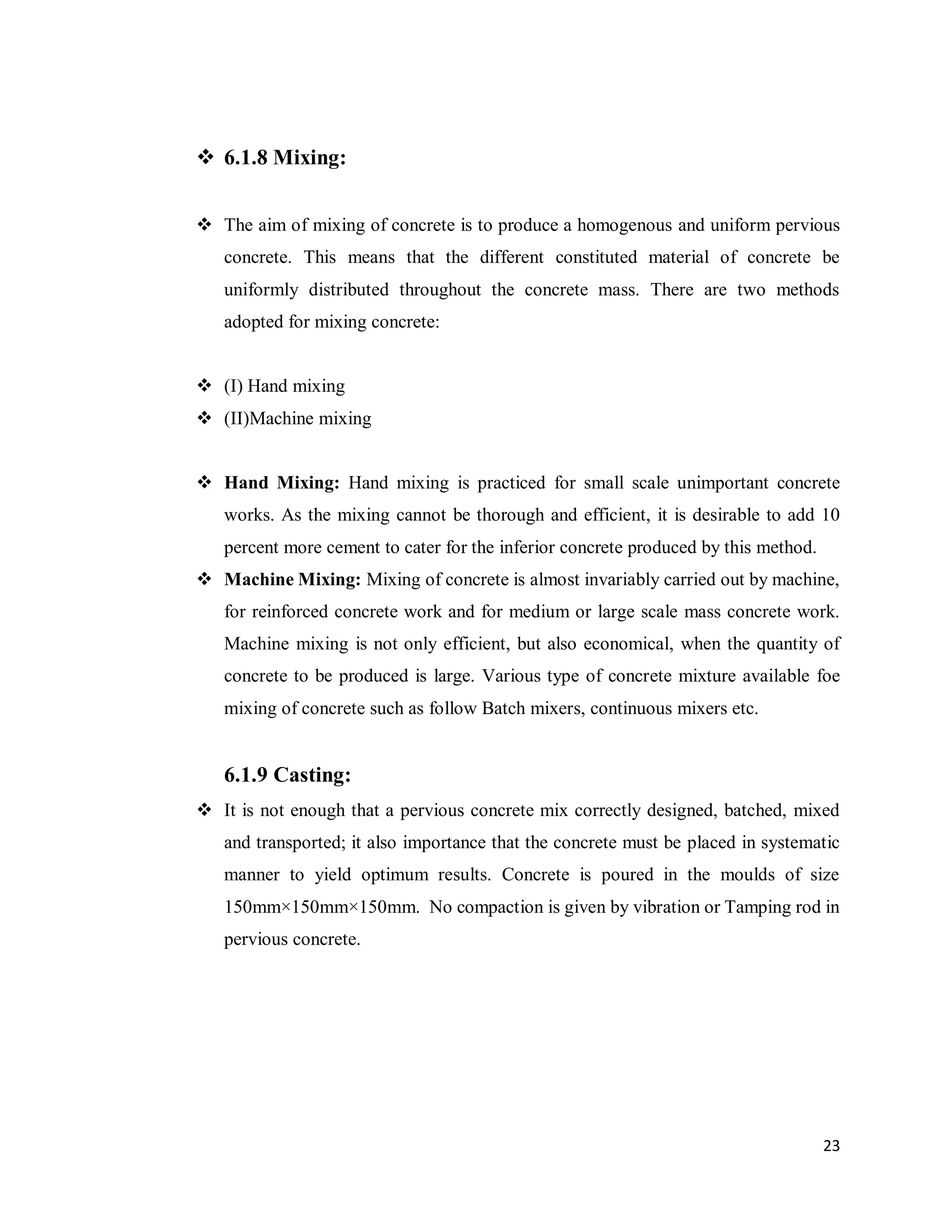
![24
6.2.0 Curing of concrete:
Concrete hardens due to chemical
reactions between Portland cement
and water. Concrete derives its
strength by the hydration of cement
particles. The hydration of cement
is not a momentary action but a
process continuing for long time.
The rate of hydration is fast to start
with, but continues over a very long time at a decreasing rate. The quantity of the
product of hydration and consequently the amount of gel formed depends upon the
extent of hydration. After 72 hours of casting the specimens is to be demoulded and
is transferred to the curing tank, wherein they will allow to cure for 28 days before
testing.
6.2.1 Hardened properties of pervious concrete :
Void content/ Porosity:-
Void content of the specimen was determined in accordance with ASTM C138-01,
standard test method for Density and air content of concrete.
A (%) = [
(𝑻−𝑫)
𝑻
]*100
Where,
A (%) = Air content (voids %) in the concrete,
T = Theoretical density of the concrete computed on an air free basis, Kg/M³,
D = Density (unit weight) of concrete, Kg/M³](https://image.slidesharecdn.com/de-2breport-180805043651/75/design-engineering-2B-report-32-2048.jpg)

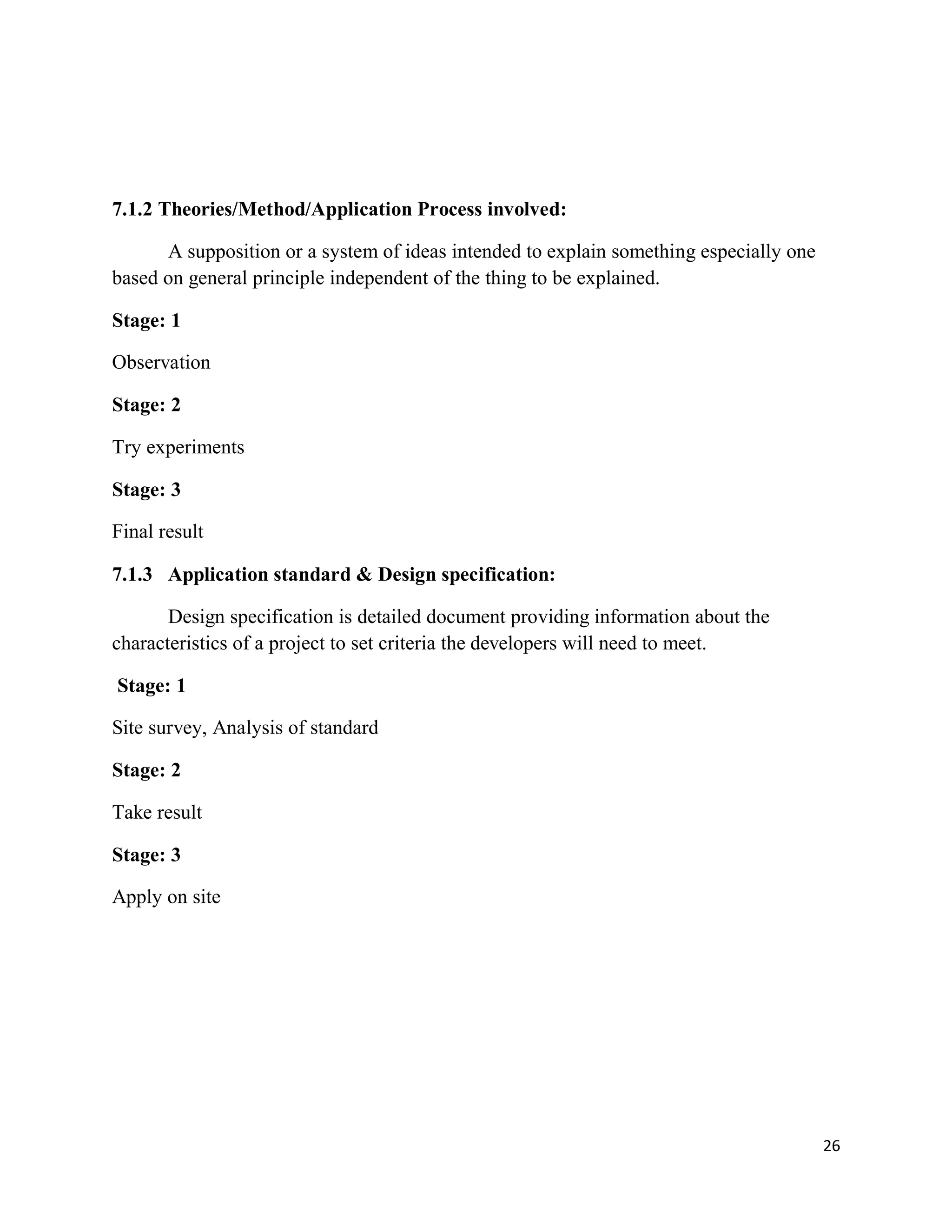

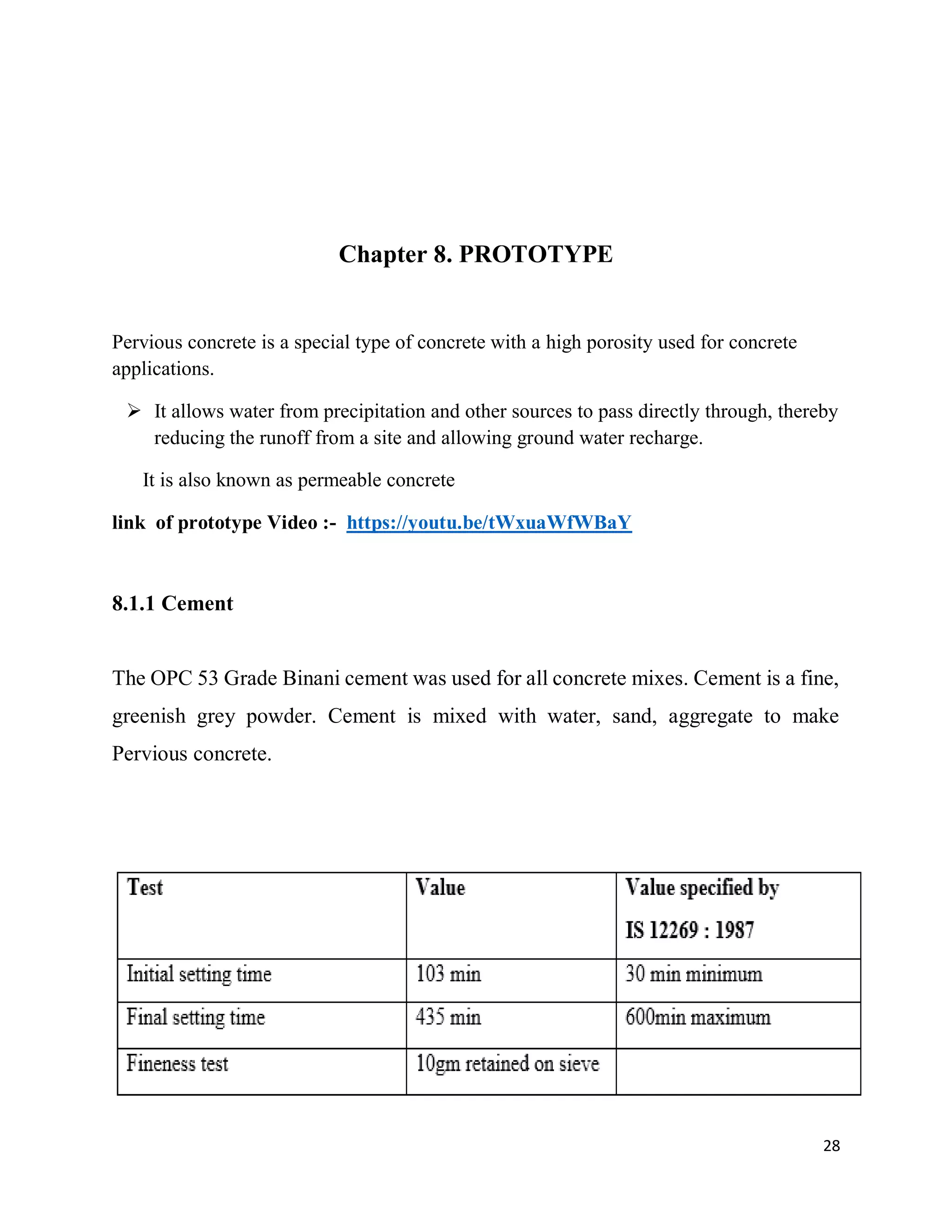


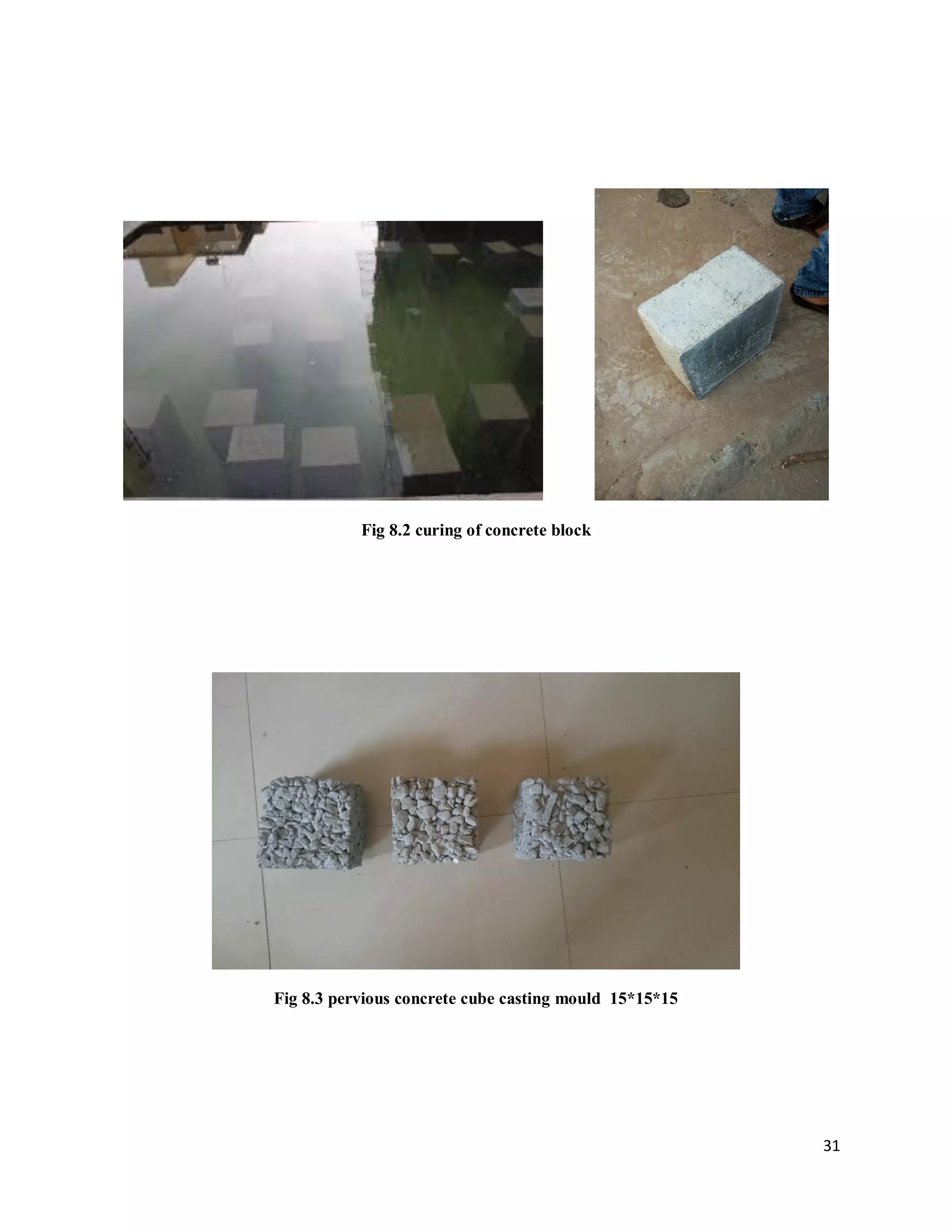
![32
8.1.4 Mix design as per NRMCA
Input data
Design void content = 20%
Aggregate relative density = 2.70
Bulk density, 𝑙𝑏 𝑓𝑡³⁄ = 101.5 lb ft³⁄ (1627Kg M³⁄ )
Absorption = 1%
𝑤 𝑐⁄ = 0.33
Step 1
SSD RDca = (2.7* 1.010) = 2.72
No sand, so y =0 and RDagg=RDca
Aggregate voids content = 1-[
101.5
2.70∗62.3
] = 39.6%
Step 2
Required PV (%) = Aggregate Void content (%) + CI (%) – Design Void content (%)
= 39.6 +5 – 20 = 24.65%
Paste volume PV, ft³ = 0.246 * 27 = 6.65 ft³
Step 3
(𝑤 𝑐⁄ ) 𝑤 = 0.33 (given)
No SCM, so x = 0 And RDcm = RDc
Step 4
Ingredient weights
(𝑤 𝑐⁄ ) 𝑣 = 0.33 * 3.15 = 1.03 (RD of cement = 3.15)
Volume of cement 𝑉𝑐 𝑚 , ft³ = [
𝑃𝑉
(1+(𝑤 𝑐⁄ ) 𝑣)
] = [
6.65
(1+1.03)
] = 3.27 ft³
Volume of water𝑉𝑤, ft³= PV- 𝑉𝑐 𝑚 = ( 6.65 – 3.27) = 3.37 ft³
Volume of voids 𝑉𝑣𝑜𝑖𝑑 , ft³ = 0.20 * 27 = 5.40 ft³
Absolute volume of aggregate = 27- (PV + 𝑉𝑣𝑜𝑖𝑑 )
= 27 – (6.65 + 5.40) = 14.95 ft³
Weight of cement, 𝑙𝑏 𝑦𝑑³⁄ = 3.27 * 3.15 * 62.4 = 642.75 (373.17Kg M³⁄ )
Weight of water, 𝑙𝑏 𝑦𝑑³⁄ = 3.37 * 1* 62.4 = 210.28 (124.75Kg M³⁄ )
Weight of aggregate, 𝑙𝑏 𝑦𝑑³⁄ = 14.95*2.72*62.4 = 2537.43 (1505.39Kg M³⁄ )](https://image.slidesharecdn.com/de-2breport-180805043651/75/design-engineering-2B-report-40-2048.jpg)
![33
8.1.5 MEASURING INSTRUMENTS/TECHNIQUES
An UNIVERSAL TESTING MACHINE (UTM) is used to find the compressive
strength of the pervious concrete.
A universal testing machine (UTM), also known as a universal tester,[1]
materials
testing machine or materials test frame, is used to test the tensile strength and
compressive strength of materials. The "universal" part of the name reflects that it
can perform many standard tensile and compression tests on materials,
components, and structures
Fig8.4 UNIVERSIAL TESTING MACHINE](https://image.slidesharecdn.com/de-2breport-180805043651/75/design-engineering-2B-report-41-2048.jpg)

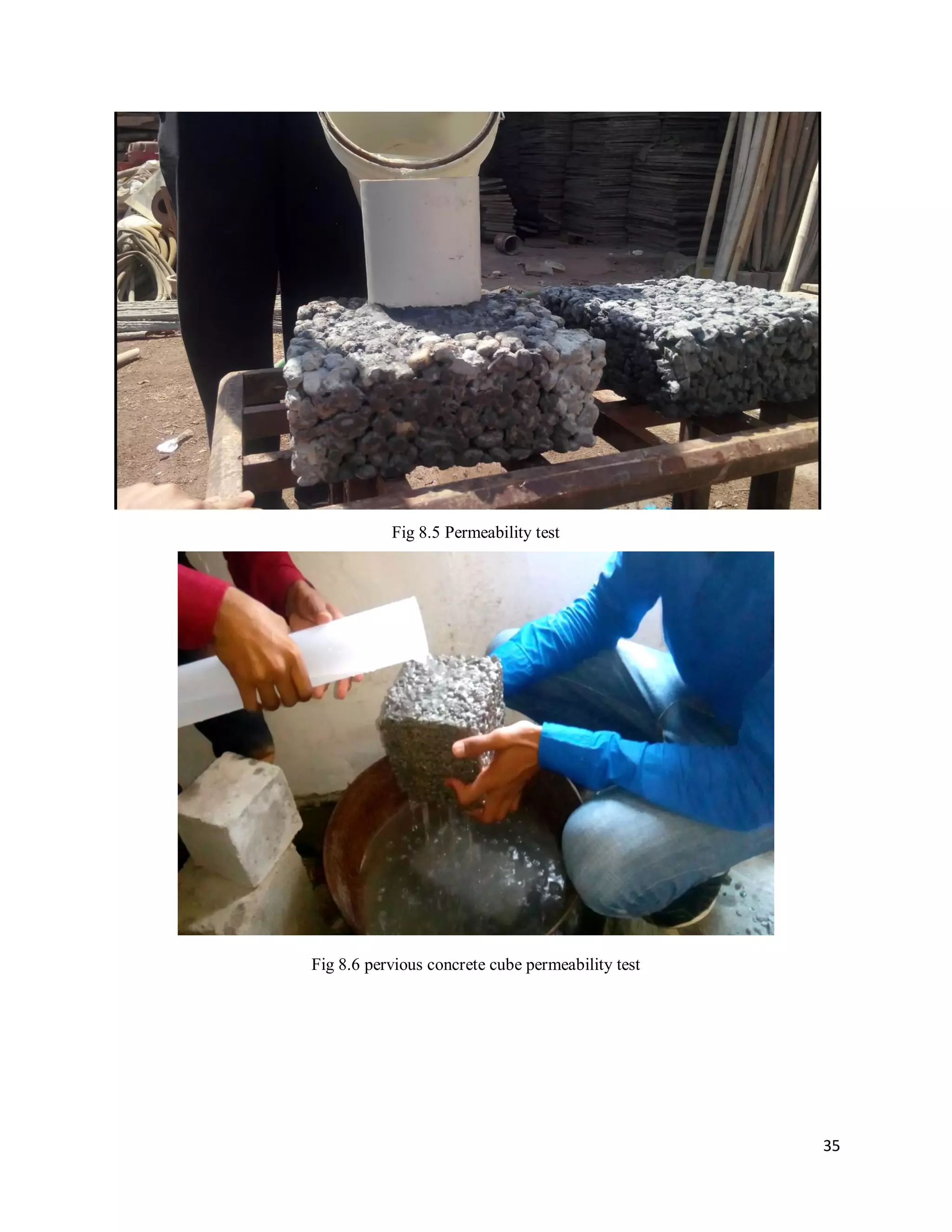


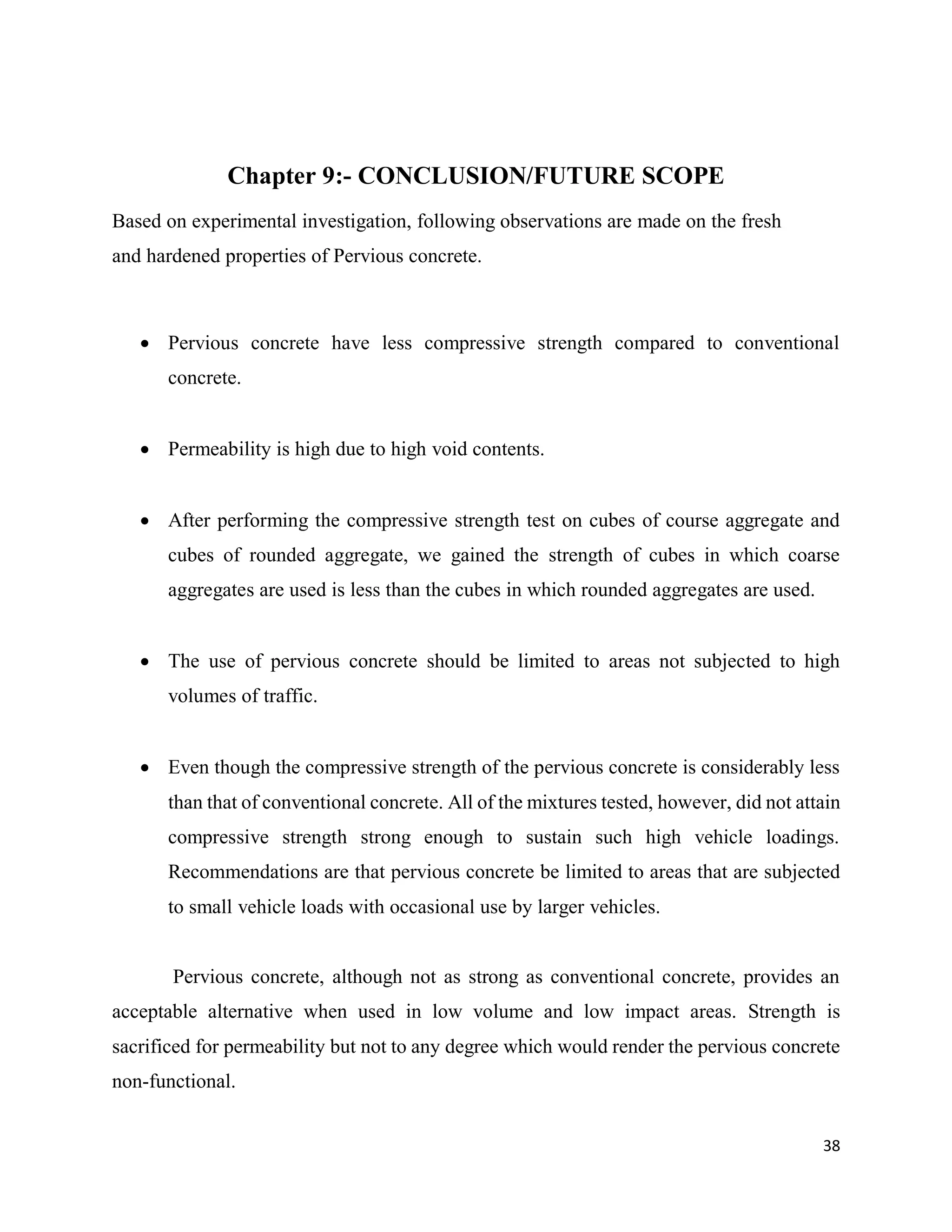
![39
Reference
Google
https://www.google.co.in/
Wikipedia, the free encyclopedia
https://en.wikipedia.org/wiki/Main_Page
Book:- concrete technology
Published by :- Atul prakashan
Author :- Dr. R.P. Rethaliya
ISBN Code :- 978-93-81-518-16-8
[1] M. Uma meguesvari and V.L. Narasimha, "Studies on characterization of pervious
concrete for pavement application " procedia -social and behavioral sciences,2013pp.
198-207.
[2] Obla. K.,"Pervious concrete an overview" India concrete journal,August,2013.pp 9-18.
[3] M.Aamer Rafique Bhurta, K, Tsuruta &J.Mirza,"Evaluation of high-performance porous
concrete properties". Construction and Building Materials, Vol.31,2012,pp.67-73.
[4] An Cheng, Hui-Mi Hsu, Sao-Jeng Chao & Kae-Long Lin."Experimental Study on
pervious concrete Made with Recycled Aggregate", Internal Journal of Pavement
Research and Technology, Vol.4,2011,NO.2, pp.l04-110.
[5] Narayanan Neithalath, Milani S. Sumanasooriya & Omkar Deo, "Characterizing pore
volume, sizes, and connectivity in pervious concretes for permeability prediction".
Materials Characterization,Vol.61, 2010,pp. 802-813.
[6] Hnzaree.C, Ceylan.H "Hig volume Fly ash concrete for pavement applications with gap](https://image.slidesharecdn.com/de-2breport-180805043651/75/design-engineering-2B-report-47-2048.jpg)
![40
graded aggregates: Marginal and fine sands", Airfield and Highway Pavements,2006,
pp.528-542.
[7] Neithalath. N., J. Weiss, and 1. Olek, "Characterizing enhanced porosity concrete using
electrical impedance (0 predict acoustic and hydraulic performance", Cement and
Concrete Research, Vo1.36, 2006,No. II, pp. 2074-2085.
[8] Tennis.p, Leming.M.L, and Akers 0.1., "Pervious concrete pavements", Portland cement
association (PCA). Skokie. Illinois, 2004. pp.25.
[9] Yang, J. and O. Jiang, "Experimental study 011 properties of pervtous concrete
pavement materials", Cement and Concrete Research, Vol.3,2002, pp. 381- 386.
[10] Ohafoori. N. and S. Dutta, "Building and nonpavement appltcations of no-
fines Concrete ", Journal of Materials in Civil Engineering, November(1995),
Vol. 7,No.4, pp. 286-289.
[11] Zouaghi. A. and M. Kumagai, "Adaptability of porous concrete to the environment", A
monthly report of the Civil Engineering Research Institute For Cold Region, 2000,
No.566: pp. 11-24.
[12] zbuge,Y., "A review of permeable concrete and its application to pavements"
Mechanics and Structures and Materials, 2006, pp. 601-607.
[13] Ohafoori, N. and S. Dutta, "Laboratory investigation of compacted no-fines concrete for
paving materials", Journal of Materials in Civil Engineering, 1995, Vol. 7, No. 3,
pp. 183-191](https://image.slidesharecdn.com/de-2breport-180805043651/75/design-engineering-2B-report-48-2048.jpg)